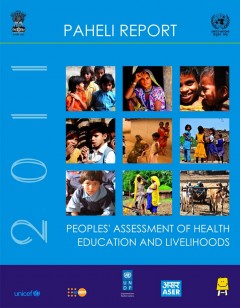
ASER Centre
Evidence for action- Home
- About Us
- ASER Survey
- Research & Assessment
- Capacity Building
- Publications & Reports
- ASER Reports
- ASER Data Over Time
- ASER 2022: Chhattisgarh
- ASER 2022 'Young Children'
- ASER 2022
- ASER 2021: West Bengal
- ASER 2021: Chhattisgarh
- ASER 2021
- ASER 2020 Wave 1
- ASER 2020 Digital Recheck
- ASER 2020: Karnataka
- ASER 2019
- ASER 2018 'Young Children'
- ASER 2018
- ASER 2017
- ASER 2016
- ASER 2015: Maharashtra
- ASER 2015 : Punjab
- ASER 2014
- ASER 2013
- ASER 2012
- ASER 2011
- ASER 2010
- ASER 2009
- ASER 2008
- ASER 2007
- ASER 2006
- ASER 2005
- Odisha Tribal Study 2022
- ASER Health Report
- Study on Access, Transition and Learning in Secondary Education
- India Early Childhood Education Impact Study
- Urban Ward Surveys
- Bihar Elementary School Study
- Inside Primary Schools
- PAHELI
- External Publications
- ASER Reports
- Data Query
- Impact
PEOPLE'S ASSESSMENT OF HEALTH, EDUCATION, AND LIVELIHOODS (PAHELI) 2011
PAHELI seeks to apply the ASER (Annual Status of Education Report) model to other social sectors in order to understand the status of key human development indicators. For basic parameters in education, ASER focuses on whether a child is in school and learning. For other sectors too, the challenge was to identify a key outcome and to develop simple tools, measures and methods to understand the status of that outcome in a given area (whether it be a neighbourhood, hamlet, village, block or district).
PAHELI 2011 is a product of these efforts. PAHELI stands for people’s assessment of health, education and livelihoods. The PAHELI framework is built around four key human development domains: Life & Livelihoods, Water & Sanitation, Education & Literacy, Mother and Infant Health & Care. Based on the Millenium Development Goals and on national priorities, PAHELI is a household survey which looks at the provision of basic services at the village level through key central government social schemes and the links of these services to households. The schemes covered in PAHELI are Sarva Shiksha Abhiyan, ICDS, public health services, PDS and MGNREGS.
The PAHELI toolkit can be used
to assess and understand the status of human development in any given area. It
can be used for a census in a hamlet, village or panchayat. It can be also be
used in a sample survey of a block or district. For
PAHELI 2011, the toolkit was used to create a district report card for human
development. PAHELI was conducted in eight districts selected across
seven states. Sixty villages were randomly selected in each district,
and twenty randomly chosen
households were surveyed per village. The findings were
captured in the form of a district report card and disseminated at the district
and state levels.
The PAHELI 2011 initiative was supported by the UN-Planning Commission Convergence Programme. In addition, two other partners provided technical know-how and resources: Arghyam in water and sanitation and Accountability Initiative for fund tracking at the local level. A set of local partners comprising organisations based in the area carried out the exercise at the local level. Government departments in each state supported the effort during training, implementation and dissemination.
PAHELI 2011 Report:
Brief Summary | Part 1 - Introduction | Part 2 - Life & Livelihood | Part 3 - Water & Sanitation | Part 4 - Maternal & Child Health | Part 5 - Education & Literacy | Annexures
Tools:
Household Questionnaire ( English / Hindi ) | Village Facilities ( English / Hindi )
District Report Cards:
Gumla ( English / Hindi ) | Hardoi ( English / Hindi ) | Nalanda ( English / Hindi ) | Korba ( English / Hindi ) |
Sundargarh ( English / Hindi ) | Rajgarh ( English / Hindi ) | Udaipur ( English / Hindi ) | Bhilwara ( English / Hindi )

© 2025 ASER CENTRE | B 4/58 Safdarjung Enclave, New Delhi 110 029 | 91 11 4602 3612 / 2671 6084